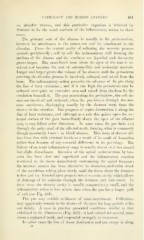Page 483 - My FlipBook
P. 483
;
PATHOLOGY AND MORBID ANATOMY. 481
on alveolar abscess, and this particular organism is believed by
Schreier to be the usual excitant of the inflammatory action in these
cases.
The primary seat of the abscess is usually hi the pericementum,
between its attachment to the cementum and its attachment to the
alveolus. From the central cavity of softening the necrotic process
spreads peripherally ; cell by cell the inflanunatory wall forming the
outlines of the abscess and the exudates are liquefied and the cavity
grows larger. The cancellated bone about the apex of the root is in-
volved and becomes the seat of osteomyelitis and molecular necrosis.
Larger and larger grows the volume of the abscess until the periosteum
covering the alveolar process is involved, softened, and raised from the
bone. The inflammatory action precedes the advance of the pus along
the line of least resistance ; and if it run high the periosteum may be
softened over quite an extensive area and raised from the bone by the
exudation beneath it. The pus penetrating the periosteum, the soft tis-
sues are involved and softened, when the pus breaks through the mu-
cous membrane, discharging usually by the shortest route from the
abscess to the exterior. The progress of septic destruction is along the
line of least resistance, and although as a rule this points upon the ex-
ternal surface of the gum immediately above the apex of the affected
root, it may follow other directions. In some cases the pus finds exit
through the pulp canal of the affected tooth, forming what is commonly
though incorrectly known as blind abscess. This form of abscess dif-
fers from that with external fistula as a result of its mode of formation
rather than because of any essential difference in its pathology. The
history of an acute inflammatory stage is usually absent or it has caused
but slight disturbance. Invasion of the apical pericementum by bac-
teria has been slow and superficial and the inflammatory reaction
restricted to the tissue immediately surrounding the apical foramen
the necrotic process has been ulcerative in character, molecular death
of the membrane taking place slowly until the tissue about the foramen
is lost and the denuded apex projects into a necrotic cavity which allows
of drainage of its contents through the foramen and root canal. In
these cases the abscess cavity is usually comparatively small, and the
inflammatory action is less severe than when the pus has a longer path
of exit (see Fig. 461),
The pus may exhibit evidences of semi-encystment. Collections
may apparently remain in the tissues of the gum for long periods with-
out fistula. A case in practice presented conditions similar to that
exhibited in the illustration (Fig. 462) ; it had existed for several years
about a replanted tooth, and responded promptly to treatment.
In other cases the line of tissue destruction and pus escape is along
31
PATHOLOGY AND MORBID ANATOMY. 481
on alveolar abscess, and this particular organism is believed by
Schreier to be the usual excitant of the inflammatory action in these
cases.
The primary seat of the abscess is usually hi the pericementum,
between its attachment to the cementum and its attachment to the
alveolus. From the central cavity of softening the necrotic process
spreads peripherally ; cell by cell the inflanunatory wall forming the
outlines of the abscess and the exudates are liquefied and the cavity
grows larger. The cancellated bone about the apex of the root is in-
volved and becomes the seat of osteomyelitis and molecular necrosis.
Larger and larger grows the volume of the abscess until the periosteum
covering the alveolar process is involved, softened, and raised from the
bone. The inflammatory action precedes the advance of the pus along
the line of least resistance ; and if it run high the periosteum may be
softened over quite an extensive area and raised from the bone by the
exudation beneath it. The pus penetrating the periosteum, the soft tis-
sues are involved and softened, when the pus breaks through the mu-
cous membrane, discharging usually by the shortest route from the
abscess to the exterior. The progress of septic destruction is along the
line of least resistance, and although as a rule this points upon the ex-
ternal surface of the gum immediately above the apex of the affected
root, it may follow other directions. In some cases the pus finds exit
through the pulp canal of the affected tooth, forming what is commonly
though incorrectly known as blind abscess. This form of abscess dif-
fers from that with external fistula as a result of its mode of formation
rather than because of any essential difference in its pathology. The
history of an acute inflammatory stage is usually absent or it has caused
but slight disturbance. Invasion of the apical pericementum by bac-
teria has been slow and superficial and the inflammatory reaction
restricted to the tissue immediately surrounding the apical foramen
the necrotic process has been ulcerative in character, molecular death
of the membrane taking place slowly until the tissue about the foramen
is lost and the denuded apex projects into a necrotic cavity which allows
of drainage of its contents through the foramen and root canal. In
these cases the abscess cavity is usually comparatively small, and the
inflammatory action is less severe than when the pus has a longer path
of exit (see Fig. 461),
The pus may exhibit evidences of semi-encystment. Collections
may apparently remain in the tissues of the gum for long periods with-
out fistula. A case in practice presented conditions similar to that
exhibited in the illustration (Fig. 462) ; it had existed for several years
about a replanted tooth, and responded promptly to treatment.
In other cases the line of tissue destruction and pus escape is along
31


